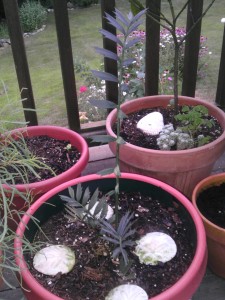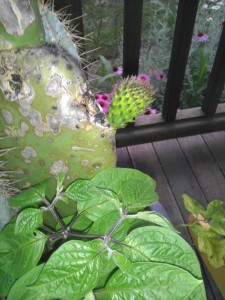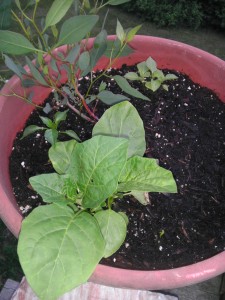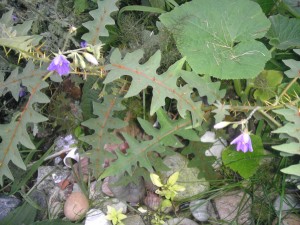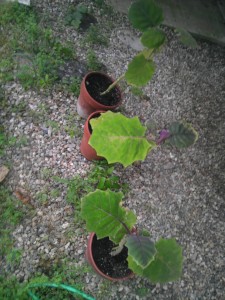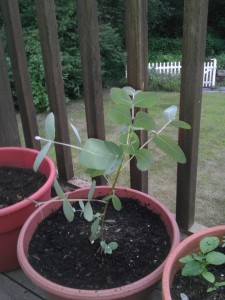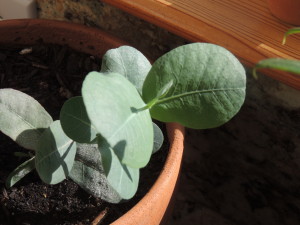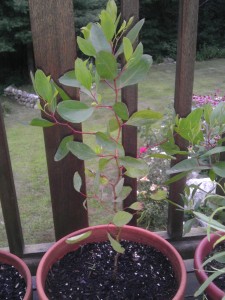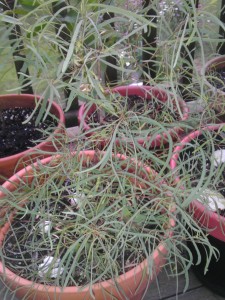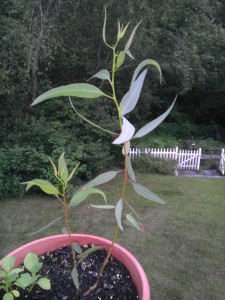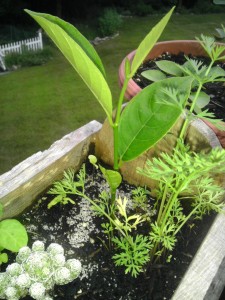Good Evening,
This post intends to build on the recent Eucalypti post, the recent July Flowers post, and to set the stage for an upcoming Solanum post. First just following the July Flowers, there’s one lily that gets much more interesting as its bloom diminishes – a whole gradient of rich colors emerge. Tulips do this sometimes too, and irises.
Next follow the Encephalartos horridus, a rare blue cycad I’ve had for this is now it’s fourth summer. http://en.wikipedia.org/wiki/Encephalartos_horridus. Not sure what makes it so horrible, except when repotting it earlier this year one little spine did stick in me and prove more irritating than usual for such a small thing. Supposedly it does not like too much moisture and getting too much diminishes its prized blueness, so I try to put it under things on rainy days and out in the sun on sunny days. Each of the first two years it sent up one stalk, last year two including the big one – I hope this year it will be vivacious but I’m not getting that feeling. Could be the weather.
A little nopalito sprout – you can eat ’em too, and that’s a spicy red rocoto in the foreground. Last Christmas I put five of those in the stuffing – they have a different heat than habaneros, very sturdy, a different flavor.
Next, since we’ve gotten to a solanum in the rocoto, some background. Last year I was on kind of a solanum spree, planting as many varieties as I could find readily on the internet, just to examine their kinship more viscerally. I’m quite fascinated at the divergent evolution of plant genomes and wonder how far they have to get apart before they cant’ cross back – now I know science has real answers for that but I always hope like Yogi Berra said “You can see a lot just by looking”. So anyway I planted porcupine tomatoes and cannibal tomatoes and lulos and pepinos and anything else I could find. The cannibal tomato apparently got it’s name because it was the ideal thing to throw in the pot with your neighbor – really brought out the flavor. I had three sprout last year, two bore fruit – I found it bitter. I saved some seeds and this year the germination was high. I certainly hope that there’s no reverse cause and effect gong on with them, that having them, well – but that’s magical realism for ya – have to be careful where you go.
continuing then, the porcupine tomatoes took a similar path except that they did not bear fruit. I was able to winter three over. These I planted in late April and they will bear fruit this year. Word is not to eat this fruit – the thorns may look scary but scarier are the special alkaloids – not to be messed with.
The pepino was planted late, I had three in the autumn, one made it to Spring, no picture just now. The lulos I went three for three on the wintering despite major insect challenges but they’ve very sensitive to heat and light and I’ve had a lot of epochs (in such a short time) of foliage die-off and regrowth. Right now they’re partially under our extruded kitchen, trying to find the right degree of shadow for them. Really hoping they will flower, not sure I can bring them across another winter indoors.
Alright, so that’s part of the present state and a partial introduction to the complete Solanum files, to be published incrementally here. Moving on to Eucalypti – you should by now be familiar with the history in context, and would that that were all, but I continued. Twice, in 2011 and 2012 I got batches of seeds, fewer in 2011 and more in 2012. A little bit more chasing of the holy grail of a Eucalyptus hardy enough to winter north of Boston, and a little bit on the chase of the gnarly seeded thing that for some reason I’ve come to believe is a kind of E. moort. Somehow during early seedling/sprout time I am certain to lose the identifiers to one malady or another, so I always end up with a collection of interesting eucalypti not all of which I can identify. First – the neglecta:
Supposedly the seeds wanted striation, six weeks at around freezing, like in the refrigerator, but I don’t know what I was thinking and I had them in the freezer for a few months. Then the summer (last) when they (there are four) were tiny (oh, wait, here’s a baby picture of this same one)
that summer was really blazing and many of the seeds were just burned to death despite thrice daily watering – 100 degrees, with oil in your leaves, just makes a sizzling bad outcome. The point of all this is that the ones who lived both through the extra long cold night in the freezer and this blazing birth rite of passage are likely to be the ones with the broadest tolerances (or so I hope) and to be fit when I put them out, not this winter but next, for that ultimate test.
Other eucalypti on the porch from the 2012 seed bonanza:
And that just about does it for this episode of Growing Things, except of course you were curious about the progress of the young giant Jack. He’s ripping.


